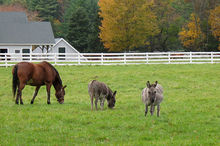Spring is here and pastures are thriving in many areas with new green growth. Veterinarians are reminding horse owners about the potential for laminitis and other negative health issues in horses that suddenly are eating grass and hay that are high in simple sugars and starches.

Preventing laminitis in horses
For extremely insulin-resistant sensitive horses, there is no completely safe time to graze, and these horses are best managed on low-carbohydrate hay.
Research shows that some horses face serious metabolic upsets that are triggered by consumption of the sugars in fresh grass. Owners of such horses need to be aware of the health consequences.
Season of the year, rainfall, temperature, frequency of mowing, plant types, and grazing pressure influence the sugar levels in pasture plants. For extremely sensitive horses, there is no completely safe time to graze. These horses are best managed on low-carbohydrate hay.
During daylight hours, grasses manufacture and store sugars as they absorb water, sunlight, and carbon dioxide. These stored sugars are used to fuel plant growth during the night. Because of this growth process, sugar levels are at their highest in late afternoon and at their lowest in the very early morning hours.
Horses that are sensitive to carbohydrate levels in pasture grass can graze with least risk from the predawn hours until around 10:00 a.m. This is a time period when stored sugars have been used and have not yet been replenished by photosynthesis.
Sensitive horses should not be allowed to graze when sugars are being built up and stored, usually during the sunlight hours and through the early hours of the night.
Breeds at risk for insulin resistance and grass founder/laminitis include:
- pony breeds
- mini horses
- donkeys
- mules
- Morgans
- Arabians
- Mustangs
- Tennessee Walking Horses
- Spotted Saddle Horses
- Paso Finos
- Peruvian Pasos
- other gaited breeds
- American Saddlebreds
- APHA Paints
- baroque breeds (PRE, Friesian, Lipizzaner, Lusitano)
